A water leak can leave your carpet a soggy mess for days. No matter the cause, you need to dry wet carpet quickly. Otherwise, it can ruin the sub-floor, walls or even lead to mold.
Depending on the amount of water, you can dry wet carpeting on your own. However, the chance of restoring your carpeting goes down the longer you wait. We cover how to get water out of the carpet as well as how long it takes to dry.
How To Dry Wet Carpet Fast
You need to move fast when drying wet carpeting to limit damage and prevent mold. The best way to dry carpet is by getting rid of the water first, then using fans to dry it out. Trying to dry it while it’s soaked with water will take much longer and can even ruin your carpeting.
Approximate Time: 3 days
Estimated Cost: $ 600
Supplies Needed
Towels
Bucket
Mop
Soap
Bleach
Baking soda
Kitty litter (optional)
Tools Needed
Pump
Wet-dry vacuum
High-volume fans
Structural drying dehumidifier
Hairdryer
Knee kicker (optional)
Steps To Get Water Out of Carpet
1. Remove the Water
Before you start drying wet carpeting, you need to get rid of the water first. If it is covered by a few inches of water, use a pump to remove it. You if need one, you can get a pump from most equipment rental companies.
If there is less than an inch of water, a wet-dry vacuum is your best option. Move slowly across the carpet to suck up as much water as possible. You may need to go over it a few times to get all the water out.
Another way to dry wet carpet is with towels. Spread them out over the wet section and press them firmly into the carpet. This works best if only a small section is wet.
If it is extremely wet, sprinkle a layer of kitty litter down first. Then press it into the carpeting with the towels. Once the kitty litter is saturated, vacuum it up with a shop vac. Repeat the process until the carpet is just barely damp to the touch. If you run out of towels, you can also use blankets as well.
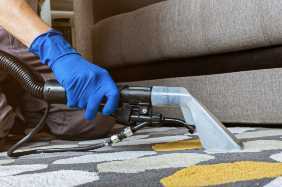
2. Dry the Wet Carpeting
If you plan to dry wet carpet in place, position fans and dehumidifiers throughout the room. Although house fans work, it’s best to rent high-volume fans and structural drying dehumidifiers. Not only will this speed up drying, but it will also prevent mold and odors. Check if it is dry every few hours and move the fans as necessary.
If possible, lift the carpeting up off the floor and position fans both above and below it. This will decrease drying time and increase the chances of saving the carpet padding and subflooring.
You can also use a hairdryer on the low or medium setting to dry smaller sections. Keep it a few inches above the carpeting and move it back and forth. You should also let it cool down before checking if it’s dry. Testing it while it’s still warm it can make the carpeting seem dry even when it’s still wet.
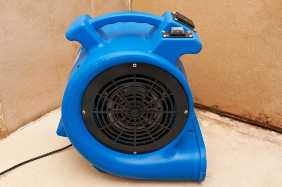
3. Check the Carpet Padding
Most carpet padding is made of a urethane foam called rebond, but older homes may have wool or fiber pads. While rebond is more resistant to water damage than wool and fiber pads, water takes its toll on all of them. Although you can try to dry the padding in place, it’s likely to retain water and take a very long time to dry.
Unfortunately, the padding will often fall apart if you try to remove it when it’s wet. If clean water caused the damage, it’s worth trying to dry the padding. However, it’s best to remove and replace it if groundwater or sewage is involved. Carpet padding is reasonably inexpensive at 30¢ to 60¢ per foot.
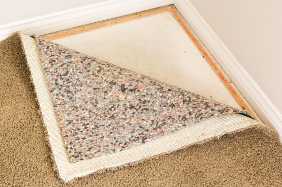
4. Check the Subfloor
If water covered the carpeting, you should check the subfloor as well. Roll back the carpeting and the padding as soon as possible. If the subfloor is still wet, use fans and dehumidifiers to dry it. Look at subfloor panels for signs of buckling and warping and replace damaged sections.
Once the subfloor is dry, disinfect the area with a cup of bleach per gallon of water. Then use a spray bottle to apply the bleach and let it air dry. Since bleach can stain carpeting, only use it to disinfect the subflooring.
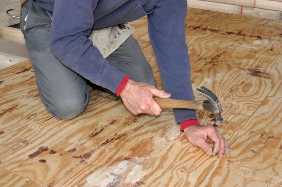
5. Reinstall the Carpeting
After disinfecting the subfloor, use a shop vac to suck up any dirt or debris. Then you can install the carpet padding. Most padding will come in rolls, but sometimes it comes in sheets or tiles. Cut the padding so it fits perfectly in the space, covering the entire area between the tack strips.
Once the padding is installed, you can reinstall your carpeting. Check that the tack strips are still in good condition and replace them if necessary. Then use a knee kicker tool to tack the carpet down to the tack strips.
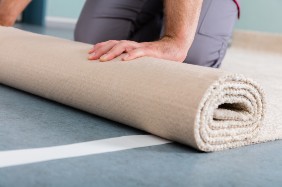
6. Clean Your Carpeting
Finally, clean your carpeting to remove stains and odors, but it will also help restore the carpet pile. You can either rent a machine to do it yourself or hire a company.
If you clean your carpets yourself, start by vacuuming them several times first to remove as much dirt and dust as possible. Then follow the instructions for your cleaner. Let the carpeting dry before you start moving furniture back into the room.
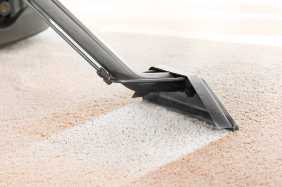
When Should You Get Rid of Wet Carpeting?
Sometimes it’s not worth the time and effort to dry wet carpet. You might want to think about throwing it away if any of the following are true:
- Sewage is involved
- It is really old or worn out
- There is mold growing already
- It was wet for days or even weeks
- You cannot dry it right away
Talk to a local pro now. Certified Restoration Local water cleanup specialists offer 24-hour service and fast, free quotes.
How Long Does It Take to Dry Carpet?
It will take between 12 and 24 hours to dry wet carpet using the right equipment and lift it up off the floor. However, it will take two to four days if you house fans or don’t lift it up.
You should dry the carpet as quickly as possible for two reasons. First, mold can start to grow in 24 to 28 hours. Second, the water can cause your carpet to fall apart. Walking on it while it’s wet will ruin it faster as well.
Don’t have the time or equipment to dry your carpet fast? We can help. Call 1-888-915-7176 now for a free quote on fast water damage cleanup and dry out.

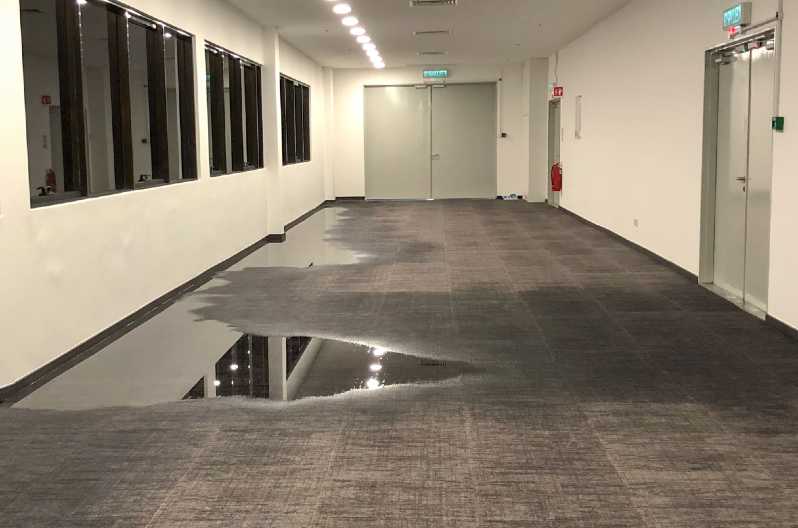




Wow! These are such great tips. Thanks for sharing them. Wet carpets are the biggest downside of carpeted floors as it may lead to mold. This may then cause health issues. Thus, it’s good to take the right measures and get rid of the dampness.